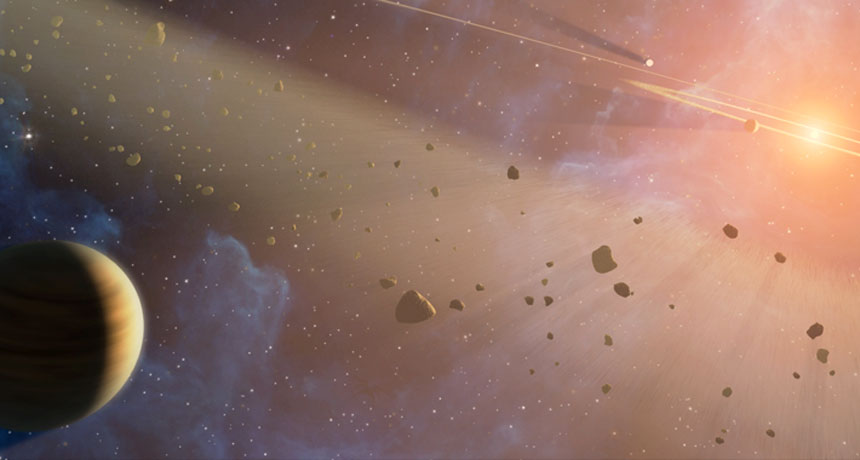Asteroid impacts may have sparked life on Earth
High energy laser collisions produce genetic bits

The energy released when asteroids and comets struck the Earth billions of years ago may have jump-started life.
NASA
Life on Earth may have begun with lots of bangs. Billions of years ago, asteroids and comets crashed into the planet. Scientists recently re-created such high-energy impacts in laser experiments. These new data suggest that ancient collisions may have released enough energy to form the building blocks of life.
Scientists still can’t travel back to when life on Earth began. But they can imitate what happened in the distant past. In the new tests, scientists beamed a high-energy laser onto a simple chemical. Called formamide (FOR-ma-myde), it probably was common on Earth long before life began.
Scientists beamed the laser energy onto formamide in hopes of simulating the energy that would be released when an asteroid collided with Earth. And in these new tests, the laser’s energy proved strong enough to form genetic fragments. They are called nucleobases (often simply called bases.)
All living things contain two types of genetic molecules. One, called DNA, is shaped like a twisted ladder. Pairs of nucleobases form its rungs. The other type of genetic molecule, called RNA, also uses pairs of these bases, but they form different structures.
“We were looking for the simplest possible scenario in which these nucleobases could have formed,” David Nesvorný told Science News. He’s a planetary scientist at the Southwest Research Institute in Boulder, Colo.
“These impacts of the past had enormous energy,” Nesvorný explains. Imagine, for example, a rock the size of Rhode Island smashing into Earth at more than 30 times the speed of sound. The energy of such an impact would cause some unusual chemical reactions, he points out.
Four billion years ago, such collisions were not unusual. During a period scientists call the Late Heavy Bombardment, space rocks rained down on Earth. To re-create the energy of those impacts, the scientists beamed light from a high-powered laser at a small pool of formamide. In the goo that was left, they found new molecules: RNA and DNA bases.
Nesvorný’s team reported its new findings December 8 in the Proceedings of the National Academy of Sciences.
“The results are exciting,” Hicham Idriss told Science News. A chemist at King Abdullah University of Science and Technology in Thuwal, Saudi Arabia, he did not work on the study. Still, he adds, such simple tests do not tell the whole story.
Nesvorný told Science News that the finding takes scientists a step closer to understanding life’s origin on Earth. And since asteroids have pummeled other planets, the new data may help explain how life began elsewhere in the cosmos.
Power Words
asteroid A rocky object in orbit around the sun. Most of these orbit in a region that falls between the orbits of Mars and Jupiter. Astronomers refer to this region as the asteroid belt.
base (in genetics) A shortened version of the term nucleobase. These bases are building blocks of DNA and RNA molecules.
comet A celestial object consisting of a nucleus of ice and dust. When a comet passes near the sun, gas and dust vaporize off the comet’s surface, creating its trailing “tail.”
cosmos A term that refers to the universe and everything within it.
DNA (short for deoxyribonucleic acid) A long, double-stranded and spiral-shaped molecule inside most living cells that carries genetic instructions. In all living things, from plants and animals to microbes, these instructions tell cells which molecules to make.
formamide Also known as methanamide, it’s an oily chemical having the formula HCONH2. Colorless, it’s moderately toxic. Among its industrial uses, it’s a solvent.
Large Heavy Bombardment A period between 4.1 and 3.8 billion years ago when the surfaces of all planets in our solar system were hit regularly by asteroids and other large rocky bodies.
laser A device that generates an intense beam of coherent light of a single color. Lasers are used in drilling and cutting, alignment and guidance, in data storage and in surgery.
molecule An electrically neutral group of atoms that represents the smallest possible amount of a chemical compound. Molecules can be made of single types of atoms or of different types. For example, the oxygen in the air is made of two oxygen atoms (O2), but water is made of two hydrogen atoms and one oxygen atom (H2O).
nitrogen A colorless, odorless and nonreactive gaseous element that forms about 78 percent of Earth’s atmosphere. Its scientific symbol is N. Nitrogen is released in the form of nitrogen oxides as fossil fuels burn.
planet A celestial object that orbits a star, is big enough for gravity to have squashed it into a roundish ball and must have cleared other objects out of the way in its orbital neighborhood. To accomplish the third feat, it must be big enough to pull neighboring objects into the planet itself or to sling-shot them around the planet and off into outer space. Astronomers of the International Astronomical Union (IAU) created this three-part scientific definition of a planet in August 2006 to determine Pluto’s status. Based on that definition, IAU ruled that Pluto did not qualify. The solar system now consists of eight planets: Mercury, Venus, Earth, Mars, Jupiter, Saturn, Uranus and Neptune.
RNA A molecule that helps “read” the genetic information contained in DNA. A cell’s molecular machinery reads DNA to create RNA, and then reads RNA to create proteins.







